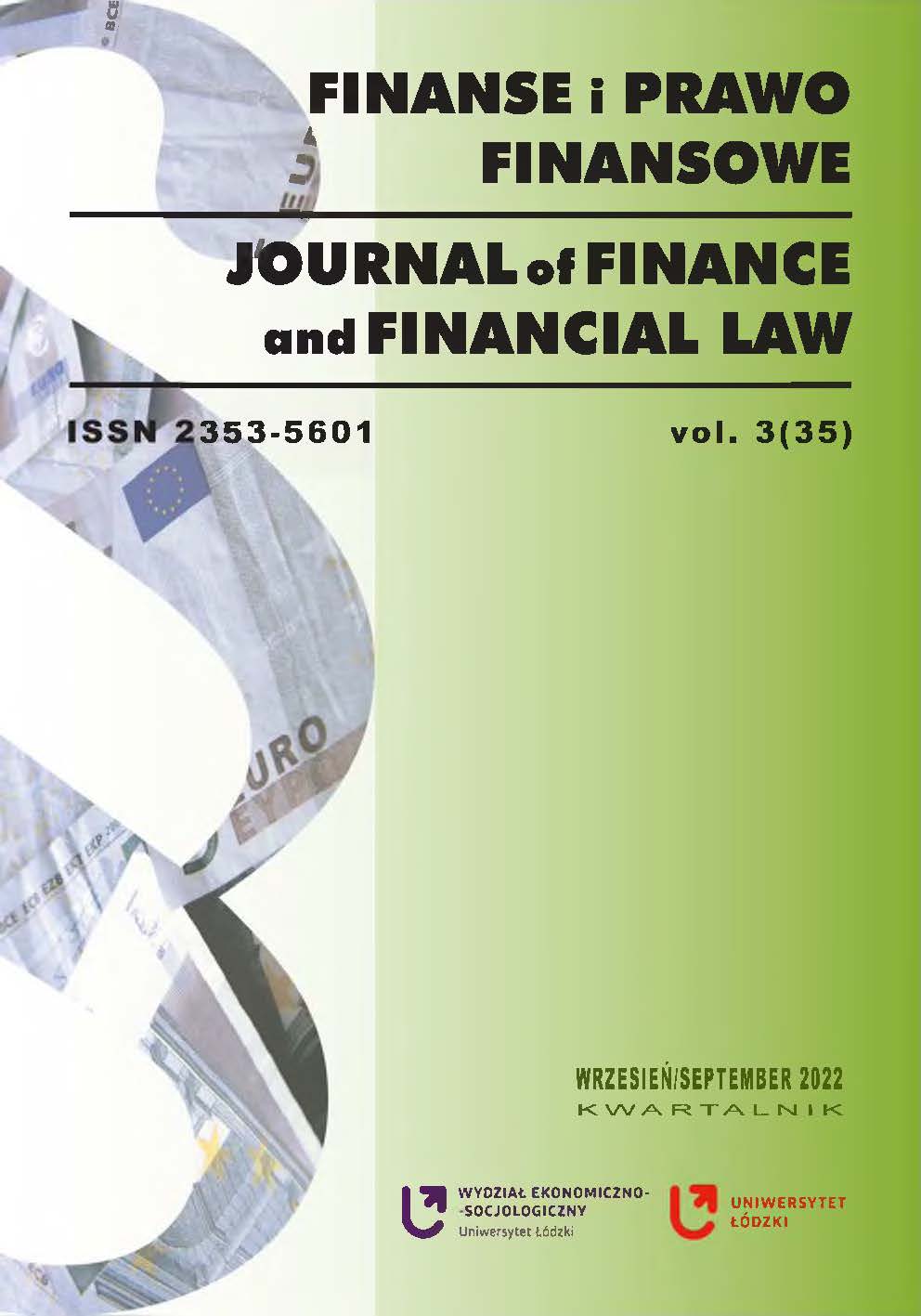Trading Volume and Capital Gains Tax - Evidence from Selected Stock Markets with Different Characteristics
DOI:
https://doi.org/10.18778/2391-6478.3.35.03Keywords:
trading volume, capital gains tax, stock markets, market liquidity, taxesAbstract
The purpose of the article/hypothesis: The goal of this paper is to investigate the relationship between capital gains tax paid by investors and the liquidity of the market, expressed by the trading volume.
Methodology: In this study, the measure of market liquidity, expressed by the trading volume, has been proposed as a variable that may be influenced by taxes on capital gains. The article presents a new approach to the analysis of the liquidity of capital markets.
Results of the research: Based on the data analysis, it was found that the higher the taxes on capital gains are paid by investors, the less likely they are to take their profits, and this is the situation on a highly developed market (the analysed US market). However, as it turns out from the results obtained, in the case of European countries representing stock markets after the systemic transformation, the higher the taxes on capital gains, the higher the share trading in these markets should be.
Downloads
References
Abankwa S., Blenman L.P. 2021, Measuring liquidity risk effects on carry trades across currencies and regimes.” Journal of Multinational Financial Management”, 60, pp. 100683.
Google Scholar
DOI: https://doi.org/10.1016/j.mulfin.2021.100683
Acharyal V., Pedersen L. H., 2005, Asset pricing with liquidity risk, „Journal of Financial Economics”, vol. 77(2), pp. 375–410.
Google Scholar
DOI: https://doi.org/10.1016/j.jfineco.2004.06.007
Akindayomi A., 2013, Capital gains taxation and stock market investments: empirical evidence. „Global Journal of Business Research”, 5(2), pp. 1–12.
Google Scholar
Amihud Y., Mendelson H., 1986a, Asset Pricing and a Bid-Ask Spread, „Journal of Financial Economics”, vol. 17, pp. 223–249.
Google Scholar
DOI: https://doi.org/10.1016/0304-405X(86)90065-6
Amihud Y., Mendelson H., 1986b, Liquidity and Stock Returns, „Financial Analysts Journal”, vol. 42, No. 3, pp. 43–48.
Google Scholar
DOI: https://doi.org/10.2469/faj.v42.n3.43
Amihud Y., Mendelson H., Pedersen L H., 2012, Market liquidity: asset pricing, risk, and crises. Cambridge University Press.
Google Scholar
DOI: https://doi.org/10.1017/CBO9780511844393
Bakri M.A., Nordin B.A.A., Tunde M.B., Theng L.W., 2020, Moderating Role of Financial Market Development on the Relationship between Stock Liquidity and Dividend, Asian Academy of Management Journal of Accounting & Finance”, 16(2).
Google Scholar
DOI: https://doi.org/10.21315/aamjaf2020.16.2.4
Bertsimas D., Lo A.W., 1998, Optimal control of execution costs, „Journal of Financial Markets”, vol. 1, issue 1, pp. 1–50.
Google Scholar
DOI: https://doi.org/10.1016/S1386-4181(97)00012-8
Chan H., Faff R., 2005, Asset Pricing and Illiquidity Premium, „The Financial Review” vol. 40, pp. 429–458.
Google Scholar
DOI: https://doi.org/10.1111/j.1540-6288.2005.00118.x
Chordia T., Roll R., Subrahmanyam A., 2000, Commonality and Liquidity, „Journal of Financial Economics”, vol. 56, Issue 1, pp. 3–28.
Google Scholar
DOI: https://doi.org/10.1016/S0304-405X(99)00057-4
Dater V., Naik N., Radcliffe R., 1998, Liquidity and Stock Returns: An Alternative Test, „Journal of Financial Markets”, vol. 1, pp. 203–219.
Google Scholar
DOI: https://doi.org/10.1016/S1386-4181(97)00004-9
Demirgüç-Kunt A., Levine R., 1996, Stock markets, corporate finance, and economic growth: an overview. „The World Bank Economic Review”, 10(2), pp. 223–239.
Google Scholar
DOI: https://doi.org/10.1093/wber/10.2.223
Dimson E., 1979, Risk measurement when shares are subject to infrequent trading, „Journal of Financial Economics”, Elsevier, vol. 7(2), pp. 197–226.
Google Scholar
DOI: https://doi.org/10.1016/0304-405X(79)90013-8
Globan T., Škrinjarić T., 2020, Penny wise and pound foolish: capital gains tax and trading volume on the Zagreb Stock Exchange. „Public Sector Economics”, 44(3), pp. 299–329.
Google Scholar
DOI: https://doi.org/10.3326/pse.44.3.2
Greenwood J., Jovanovic B., 1990, Financial development, growth, and the distribution of income. „Journal of political Economy”, 98(5, Part 1), pp. 1076–1107.
Google Scholar
DOI: https://doi.org/10.1086/261720
Hossin M.S., Hamid M.K., 2021, Capital Market Performance and Bangladesh’s Economy: An Empirical Study. „Global Business Review”.
Google Scholar
DOI: https://doi.org/10.1177/0972150920982247
Ibrahim M., Alagidede P., 2018, Nonlinearities in financial development–economic growth nexus: Evidence from sub-Saharan Africa. „Research in International Business and Finance”, 46, pp. 95–104.
Google Scholar
DOI: https://doi.org/10.1016/j.ribaf.2017.11.001
Imai K., Kim I.S., 2021, On the use of two-way fixed effects regression models for causal inference with panel data. „Political Analysis”, 29(3), pp. 405–415.
Google Scholar
DOI: https://doi.org/10.1017/pan.2020.33
Karinga E.N., 2015, The announcement effect of capital gains tax on stock performance at Nairobi Securities Exchange, Doctoral dissertation, University of Nairobi.
Google Scholar
King R.G., Levine R., 1993, Finance, entrepreneurship and growth. „Journal of Monetary economics”, 32(3), pp. 513–542.
Google Scholar
DOI: https://doi.org/10.1016/0304-3932(93)90028-E
Nordin S., Nordin N., 2016, The impact of capital market on economic growth: A Malaysian outlook. „International Journal of Economics and Financial Issues”, 6(7), pp. 259–265.
Google Scholar
Obadha L.A., 2019, An Event study on effects of Kenya’s varying application of Capital Gains Tax on stock market performance at Nairobi Securities Exchange, Doctoral dissertation, Strathmore University.
Google Scholar
Orhan A., Kirikkaleli D., Ayhan F., 2019, Analysis of wavelet coherence: service sector index and economic growth in an emerging market. „Sustainability,” 11(23), pp. 6684.
Google Scholar
DOI: https://doi.org/10.3390/su11236684
Ouyang Y., 2016, Concept: Comprehensive Advantages of Large Countries (CAOLC). In The Development of BRIC and the Large Country Advantage, Springer, Singapore, pp. 31–56.
Google Scholar
DOI: https://doi.org/10.1007/978-981-10-0633-3_3
Pastor L., Stambaugh R.F., 2003, Liquidity risk and expected stock returns, „Journal of Political Economy” 111, pp. 642–685.
Google Scholar
DOI: https://doi.org/10.1086/374184
Saccone D., Deaglio M. 2020, Poverty, emergence, boom and affluence: a new classification of economies. „Economia Politica”, 37(1), pp. 267–306.
Google Scholar
DOI: https://doi.org/10.1007/s40888-019-00166-4
Sadka R., 2006, Momentum and post-earnings announcement drift anomalies: The role of liquidity risk, „Journal of Financial Economics” 80, pp. 309–349.
Google Scholar
DOI: https://doi.org/10.1016/j.jfineco.2005.04.005
Samarasinghe A., Uylangco K., 2021, Stock market liquidity and traditional sources of bank business. „Accounting & Finance”.
Google Scholar
DOI: https://doi.org/10.1111/acfi.12883
Shannon P., Reilly R., Schweihs R., 2000, Valuing a Business: The Analysis and Appraisal of Closely Held Companies. McGraw-Hill Library of Investment and Finance, 4th Edition (Hardcover), pp. 3–28.
Google Scholar
Verbeek M., 2017, A guide to modern econometrics. John Wiley & Sons.
Google Scholar
Wooldridge J.M., 2005, Fixed-effects and related estimators for correlated random-coefficient and treatment-effect panel data models. „Review of Economics and Statis-tics”, 87(2), pp. 385–390.
Google Scholar
DOI: https://doi.org/10.1162/0034653053970320
Youhao,T., 1999, On Big Country's Economy also on Chinese Economic Development Strategy „Reform of Economic System”.
Google Scholar
Downloads
Published
How to Cite
Issue
Section
License

This work is licensed under a Creative Commons Attribution-NonCommercial-NoDerivatives 4.0 International License.














